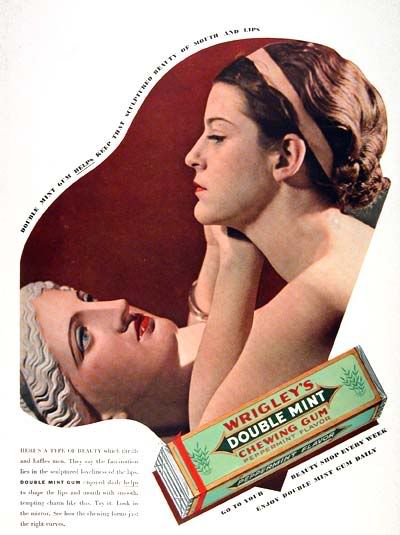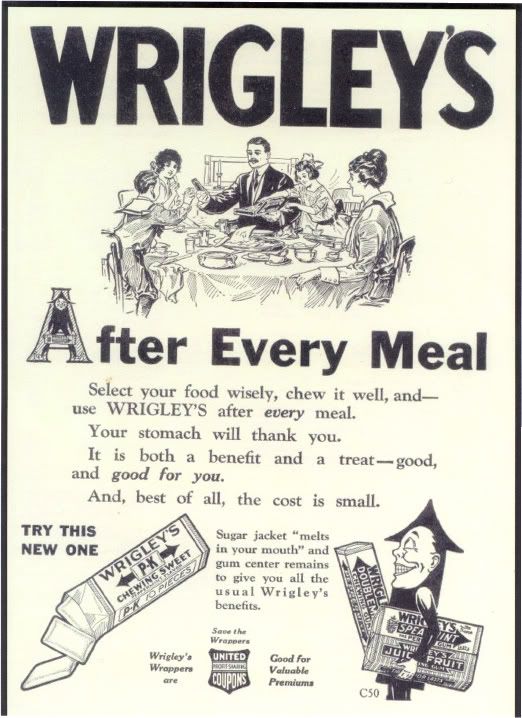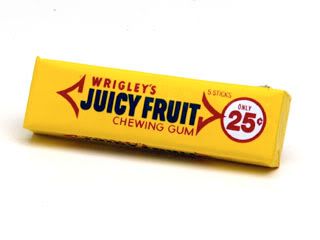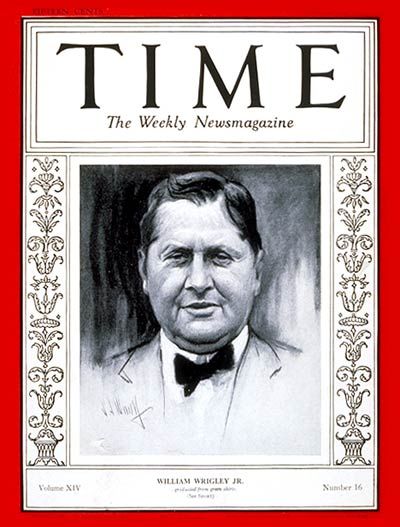Great Ideas
© Thomas Wilson Shawcross 11 Sep 2005
I keep thinking about the Creative Process and how great ideas occur. I have written about this before, see my story “Popeye” of 25 May 2005 and my story “How I Create” of 22 Apr 2005.
Other than the annoying discrepancy of Nikola Tesla’s “spontaneous” invention of the alternating current motor, it appears to me that the Creative Process is cumulative, and it involves a lot of trial and error. I discovered another example of this last night when, as I suppose we all do at some point in our lives, I was researching the life of William Wrigley, Jr.
Ok, maybe we don’t ALL research William Wrigley, Jr., but I am interested in him, as I have on two occasions blundered into seeing mansions that he once occupied. The first occasion was when I was Best Man at a wedding at the Arizona Biltmore Hotel in Phoenix. From there, I could see a hilltop crowned by the building that had been the last home occupied by William Wrigley, Jr. (who also owned the Arizona Biltmore, where, by the way, Irving Berlin wrote “White Christmas” and several other songs while sitting by the pool).
But, I digress. The second occasion was when I first visited Santa Catalina Island. William Wrigley, Jr. had purchased the island and built the most modest of his several homes there, atop a mountain, where it caught the first rays of sun in the morning and the last rays at night. I toured that home, and it was there that I got my first insight into the benefits that Great Ideas can bring.
A windowed dining room at the back of the Catalina mansion looked out over a baseball field far below. It was there that the Chicago Cubs used to conduct their Spring Training (Wrigley owned the Cubs too). I imagined myself as William Wrigley, Jr., sitting in my mansion breakfast nook, looking down upon my Major League baseball team as I enjoyed my second cup of General Foods International Coffee – it was Suisse Mocha, as I recall.
Now you alert readers might say, “But Tom, General Foods did not introduce their crappy line of instant coffees until 1973, and William Wrigley, Jr. died in the bedroom of his Phoenix home in 1932!”
That is a good point, but my fantasies are not bound by strict timelines, and at the time I did like that particular coffee, partly because it was instant and therefore required no “cooking.” Since that time, I have discovered the joys of real coffee . . . albeit not of cooking.
But, I digress again. This story is supposed to be about Great Ideas and How to Get Them. I am not sure what the requirements are for qualifying as a Great Idea, but as a rule of thumb, I would say that if an idea can make you a billionaire then it is a Great Idea, and so Wrigley had a great idea.
As I read about the life of William Wrigley, Jr., I learned that he came to Chicago in April 1891 with just $32 in his pocket but a lot of ability as a salesman and entrepreneur. His father had been a soap manufacturer in Philadelphia, and with some seed money provided by his uncle, he started selling Wrigley’s Scouring Soap. As a premium to help sell the soap, he began offering free cans of baking soda, on the premise that the merchants would be more likely to carry his soap product if they received “a little something for nothing.”
The baking soda proved to be more popular than the soap, so Wrigley began offering the premium of two free packs of chewing gum (made by the Zeno Manufacturing Company) with each can of baking soda. Again, the premium became more popular than the product it was supposed to promote, so in 1892 he began selling gum under his own name.
His first two brands were Lotte and Vassar. I don’t know about you, but I don’t hear much about those brands anymore. But Wrigley persevered, and in 1893 he came up with Juicy Fruit and Spearmint. Now, he had crossed the threshold into Great Idea territory.
This is not to say that from there he coasted into his mansions in Illinois, Wisconsin, California, and Arizona. The company nearly went bankrupt several times, as he fought off a cartel of competitors. But Wrigley had more great ideas. He persuaded restaurant owners to place gum next to their cash registers (and made marketing history by doing so). In the early years, gum was marketed as a product that improved digestion. Later, even more creative ideas were used to sell gum. Note this 1936 ad that advised women to chew gum daily in order to “sculpt” the loveliness of their lips:

“Go to your beauty shop every week - Enjoy Double Mint Gum daily."
Wrigley did not come up with the Great Idea for making chewing gum, and he did not even come up with the Great Idea for making it as his initial product. Furthermore, he was surprised when he discovered that people wanted to buy just the gum and not the baking soda. His Great Ideas were more in the realm of product marketing. By 1911, Wrigley’s Spearmint was the best-selling gum in the US. In 1915, Bill Wrigley mailed four sticks of gum to each of the 1.5 million people who were listed in US phone books. In 1919, he repeated the mailing, this time to 7 million people.

In this 1920 ad, consumers were advised to chew gum after every meal. Note they were also advised to save the Wrigley gum wrappers for valuable premiums. There was a catalogue for ordering the gum premiums, but this time the premiums (razors, scales, etc.) did not become more popular than the product.
By the time of his death in 1932, William Wrigley, Jr. had spent more than $100 million in product marketing, and Wrigley’s dominated the world gum market. To be fair, not all of the success of the present-day company is due to great marketing ideas – a Wrigley employee once told me of her first day on the job, when her manager ordered her to “walk the rack” of a competitor. In the terminology of retail distribution, this means to take the display rack of a competitor outside the store and stomp on it.
(Note to self: include this story in future article with working title “The Seamy Underbelly of Retail").
But, the Wrigley Company remains creative. Last year, it purchased the Altoids ®, Life Savers ®, and Crème Savers ® candy brands from Kraft Foods for $1.4 billion cash.
Was this another Great Idea? Time will tell. What is apparent, however, is that William Wrigley, Jr. had several Great Ideas, and they weren’t the first ones that popped into his head. It seems he never stopped thinking up new ideas, and this may be one of the reasons he was so successful.
Certainly, that seems to be a key component. There may be moments of epiphany, but Really Great Ideas seem to need lots of extra work. Einstein pondered some of his physics problems for years before coming up with the right answers. Most people stop thinking hard after ten or twenty minutes if they haven’t come up with a good idea. Perhaps if they stuck with it, they would have gotten a Great Idea. Did J. K. Rowling ponder for twenty-one minutes and then come up with Harry Potter? Could be . . . I will have to give this some more thought (when I have more time to devote to it).
I will close with an image of my favorite Wrigley’s gum (which is no longer produced using the same formula that it used to have). What’s your favorite?


William Wrigley, Jr. 1861-1932
“When two men in business always agree, one of them is unnecessary.”
I keep thinking about the Creative Process and how great ideas occur. I have written about this before, see my story “Popeye” of 25 May 2005 and my story “How I Create” of 22 Apr 2005.
Other than the annoying discrepancy of Nikola Tesla’s “spontaneous” invention of the alternating current motor, it appears to me that the Creative Process is cumulative, and it involves a lot of trial and error. I discovered another example of this last night when, as I suppose we all do at some point in our lives, I was researching the life of William Wrigley, Jr.
Ok, maybe we don’t ALL research William Wrigley, Jr., but I am interested in him, as I have on two occasions blundered into seeing mansions that he once occupied. The first occasion was when I was Best Man at a wedding at the Arizona Biltmore Hotel in Phoenix. From there, I could see a hilltop crowned by the building that had been the last home occupied by William Wrigley, Jr. (who also owned the Arizona Biltmore, where, by the way, Irving Berlin wrote “White Christmas” and several other songs while sitting by the pool).
But, I digress. The second occasion was when I first visited Santa Catalina Island. William Wrigley, Jr. had purchased the island and built the most modest of his several homes there, atop a mountain, where it caught the first rays of sun in the morning and the last rays at night. I toured that home, and it was there that I got my first insight into the benefits that Great Ideas can bring.
A windowed dining room at the back of the Catalina mansion looked out over a baseball field far below. It was there that the Chicago Cubs used to conduct their Spring Training (Wrigley owned the Cubs too). I imagined myself as William Wrigley, Jr., sitting in my mansion breakfast nook, looking down upon my Major League baseball team as I enjoyed my second cup of General Foods International Coffee – it was Suisse Mocha, as I recall.
Now you alert readers might say, “But Tom, General Foods did not introduce their crappy line of instant coffees until 1973, and William Wrigley, Jr. died in the bedroom of his Phoenix home in 1932!”
That is a good point, but my fantasies are not bound by strict timelines, and at the time I did like that particular coffee, partly because it was instant and therefore required no “cooking.” Since that time, I have discovered the joys of real coffee . . . albeit not of cooking.
But, I digress again. This story is supposed to be about Great Ideas and How to Get Them. I am not sure what the requirements are for qualifying as a Great Idea, but as a rule of thumb, I would say that if an idea can make you a billionaire then it is a Great Idea, and so Wrigley had a great idea.
As I read about the life of William Wrigley, Jr., I learned that he came to Chicago in April 1891 with just $32 in his pocket but a lot of ability as a salesman and entrepreneur. His father had been a soap manufacturer in Philadelphia, and with some seed money provided by his uncle, he started selling Wrigley’s Scouring Soap. As a premium to help sell the soap, he began offering free cans of baking soda, on the premise that the merchants would be more likely to carry his soap product if they received “a little something for nothing.”
The baking soda proved to be more popular than the soap, so Wrigley began offering the premium of two free packs of chewing gum (made by the Zeno Manufacturing Company) with each can of baking soda. Again, the premium became more popular than the product it was supposed to promote, so in 1892 he began selling gum under his own name.
His first two brands were Lotte and Vassar. I don’t know about you, but I don’t hear much about those brands anymore. But Wrigley persevered, and in 1893 he came up with Juicy Fruit and Spearmint. Now, he had crossed the threshold into Great Idea territory.
This is not to say that from there he coasted into his mansions in Illinois, Wisconsin, California, and Arizona. The company nearly went bankrupt several times, as he fought off a cartel of competitors. But Wrigley had more great ideas. He persuaded restaurant owners to place gum next to their cash registers (and made marketing history by doing so). In the early years, gum was marketed as a product that improved digestion. Later, even more creative ideas were used to sell gum. Note this 1936 ad that advised women to chew gum daily in order to “sculpt” the loveliness of their lips:

“Go to your beauty shop every week - Enjoy Double Mint Gum daily."
Wrigley did not come up with the Great Idea for making chewing gum, and he did not even come up with the Great Idea for making it as his initial product. Furthermore, he was surprised when he discovered that people wanted to buy just the gum and not the baking soda. His Great Ideas were more in the realm of product marketing. By 1911, Wrigley’s Spearmint was the best-selling gum in the US. In 1915, Bill Wrigley mailed four sticks of gum to each of the 1.5 million people who were listed in US phone books. In 1919, he repeated the mailing, this time to 7 million people.

In this 1920 ad, consumers were advised to chew gum after every meal. Note they were also advised to save the Wrigley gum wrappers for valuable premiums. There was a catalogue for ordering the gum premiums, but this time the premiums (razors, scales, etc.) did not become more popular than the product.
By the time of his death in 1932, William Wrigley, Jr. had spent more than $100 million in product marketing, and Wrigley’s dominated the world gum market. To be fair, not all of the success of the present-day company is due to great marketing ideas – a Wrigley employee once told me of her first day on the job, when her manager ordered her to “walk the rack” of a competitor. In the terminology of retail distribution, this means to take the display rack of a competitor outside the store and stomp on it.
(Note to self: include this story in future article with working title “The Seamy Underbelly of Retail").
But, the Wrigley Company remains creative. Last year, it purchased the Altoids ®, Life Savers ®, and Crème Savers ® candy brands from Kraft Foods for $1.4 billion cash.
Was this another Great Idea? Time will tell. What is apparent, however, is that William Wrigley, Jr. had several Great Ideas, and they weren’t the first ones that popped into his head. It seems he never stopped thinking up new ideas, and this may be one of the reasons he was so successful.
Certainly, that seems to be a key component. There may be moments of epiphany, but Really Great Ideas seem to need lots of extra work. Einstein pondered some of his physics problems for years before coming up with the right answers. Most people stop thinking hard after ten or twenty minutes if they haven’t come up with a good idea. Perhaps if they stuck with it, they would have gotten a Great Idea. Did J. K. Rowling ponder for twenty-one minutes and then come up with Harry Potter? Could be . . . I will have to give this some more thought (when I have more time to devote to it).
I will close with an image of my favorite Wrigley’s gum (which is no longer produced using the same formula that it used to have). What’s your favorite?


William Wrigley, Jr. 1861-1932
“When two men in business always agree, one of them is unnecessary.”


0 Comments:
Post a Comment
<< Home